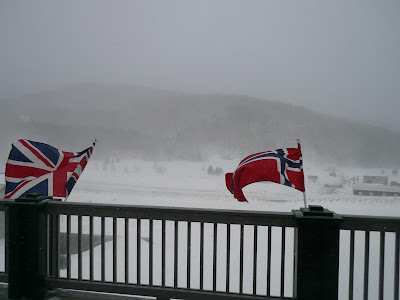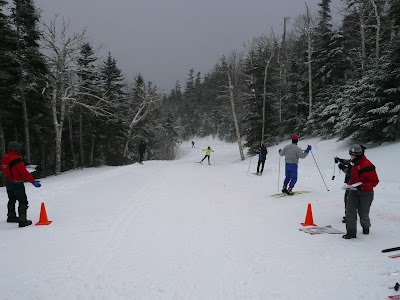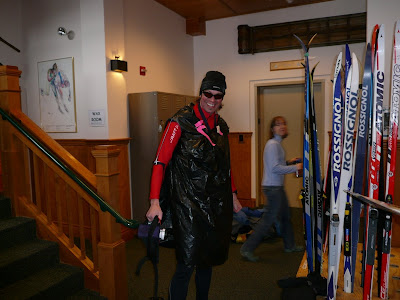Otis Singlespeed Trail Ride
30.8mi, 3:11hrs, 4600ft vert
 Rather than ranting about about the fresh snow dump in southern NH on Friday, I took it as a suggestion I should do something other than another long road ride with hill intervals. The Cape escaped precip pretty much altogether. It was supposed to be windy too, which would further make a messy road slog even more miserable. It was a no brainer. Take the singlespeed trail bike to Otis.
Rather than ranting about about the fresh snow dump in southern NH on Friday, I took it as a suggestion I should do something other than another long road ride with hill intervals. The Cape escaped precip pretty much altogether. It was supposed to be windy too, which would further make a messy road slog even more miserable. It was a no brainer. Take the singlespeed trail bike to Otis.Using Colin R's suggested route, I had no traffic fiascos this time. It isn't too often I go mountain biking with fresh legs, so this was going to be a real treat. No big hills here though, just lots of short to medium punchy climbs. With a singlespeed, this means a low cadence, high muscular force workout. I don't do
 any weight or strength training off the bike, so this is how I get it.
any weight or strength training off the bike, so this is how I get it.I hit numerous new trails. Having a map started by another rider with a GPS didn't really help me find some of the areas I was looking for. The network is so dense and completely unmarked. I rode three hours and probably only covered a third of rideable trails. Conditions were so dry that some areas were getting loose and sandy. Some recent motorized dirt bike traffic was partly behind this. I did snag sticks into the rear wheel multiple times, but unlike last time at Trail of Tears, I had no derailleur to suck into the spokes. I was completely cooked finishing the ride, hammering most of the time.
Sunday, March 30
Waterville Valley Skate Ski
38.0km, 2:43hrs, 1062m vert
 So how do you top a perfect trail ride? Go skiing the next day. Temps were forecast to be mild, and the grooming report said conditions were as good as they can get. Today was probably my last chance to ski this season. I was not disappointed. Immediately after setting off, I knew it was going to be a great ski despite sore legs from yesterday's 1x1 frenzy. I ranked the conditions as such: Control-10, Speed-7, and Weather-10. This was my best overall skiing conditons this season.
So how do you top a perfect trail ride? Go skiing the next day. Temps were forecast to be mild, and the grooming report said conditions were as good as they can get. Today was probably my last chance to ski this season. I was not disappointed. Immediately after setting off, I knew it was going to be a great ski despite sore legs from yesterday's 1x1 frenzy. I ranked the conditions as such: Control-10, Speed-7, and Weather-10. This was my best overall skiing conditons this season.With a big trip coming up in a couple days, I didn't not need an injury or overdo any muscles such that I would feel them on my big ride planned Wednesday. I also told myself I would not ski up Beanbender, as that always kills my back. Yet the hills came pretty easily. From the Nordic Center, I went out Swan's and right up Tripoli, nearly 1000ft net gain. Upper Osceola was the next major peak, then the Livermore/Cascade combo. I thought that would have killed me, as I hadn't skied in two weeks, and before that I was only skiing once per week. But I was still good. Stellar conditions have that kind of psychological impact I suppose. From summit of Cascade, I bombed down Lower Snow's, knowing that the only escape route I'd end up taking would be going up Beanbender. There just ain't no way to "soft-pedal" that puppy. As I rounded the last bend and
 strained my neck to look up at the summit, I see another skier up there standing, watching my struggling progress. It was none other than Brad Ek (NHCC rider). After commenting that I took the hard way up, he confirmed that today was the best ski day of the year. Brilliant cloudless skies, zero wind, temp just above freezing at that point, and meticulously groomed corduroy. Another skier came up while we were talking and marveled at the conditions. Brad said he'd take skiing on a day like today over the Marblehead bike race any day. I agreed.
strained my neck to look up at the summit, I see another skier up there standing, watching my struggling progress. It was none other than Brad Ek (NHCC rider). After commenting that I took the hard way up, he confirmed that today was the best ski day of the year. Brilliant cloudless skies, zero wind, temp just above freezing at that point, and meticulously groomed corduroy. Another skier came up while we were talking and marveled at the conditions. Brad said he'd take skiing on a day like today over the Marblehead bike race any day. I agreed. GPS track from top of Tripoli (Thornon Gap) looking across valley to Cascade Brook, Snows, and Beanbender. Photo above is looking opposite way across at Thornton Gap
GPS track from top of Tripoli (Thornon Gap) looking across valley to Cascade Brook, Snows, and Beanbender. Photo above is looking opposite way across at Thornton GapI took the long way back to wrap up the day. By 1pm, the lower open areas were getting softened by the high sun, making the going just a little slower and more challenging. Alternating between fast shaded areas and slow sunny areas can cause endo's. This was one of my easiest ski sessions ever, averaging only 132bpm (72% max HR). There were very few people out today, which is a shame given the conditions.
Next up are a couple recovery days. Flight to Phoenix leaves Tuesday evening. Bike should be waiting for me when I get to hotel in Tucson. Forecast shows 10% chance of rain Wednesday, high around 80F in Tucson, about 60F at 9100ft Mt Lemmon Summit. Planned ride will be twice as long as anything I've done so far this year.





















